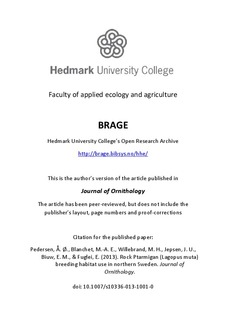| dc.contributor.author | Pedersen, Åshild Ø. | |
| dc.contributor.author | Blanchet, Marie-Anne | |
| dc.contributor.author | Hörnell-Willebrand, Maria | |
| dc.contributor.author | Jepsen, Jane U. | |
| dc.contributor.author | Biuw, Martin | |
| dc.contributor.author | Fuglei, Eva | |
| dc.date.accessioned | 2013-09-20T07:33:36Z | |
| dc.date.issued | 2013 | |
| dc.identifier.citation | Pedersen, Å. Ø., Blanchet, M.-A. E., Willebrand, M. H., Jepsen, J. U., Biuw, E. M., & Fuglei, E. (2013). Rock Ptarmigan (Lagopus muta) breeding habitat use in northern Sweden. Journal of Ornithology. doi: 10.1007/s10336-013-1001-0 | no_NO |
| dc.identifier.uri | http://hdl.handle.net/11250/134578 | |
| dc.description | This is the postprint version of the article. The published article can be located at www.springerlink.com | no_NO |
| dc.description.abstract | Alpine and arctic tundra regions are likely to retract as a result of climate warming and concerns have been raised over the status of the Rock Ptarmigan (Lagopus muta). In Fennoscandia, the Rock Ptarmigan has low population abundance, and predictions based on harvest statistics show population declines throughout the range. In this study, we used a long-term opportunistic dataset of Rock Ptarmigan observations, environmental predictors derived from a digital vegetation map and a digital elevation model to describe the breeding distribution at three different ecological scales. Patterns of spatial distribution were similar across all the three study scales. The presence of permanent snow-fields positively influenced the occurrence of Rock Ptarmigan at the territory and landscape scale. Open vegetation, rock-dominated areas and, in particular, dry heath influenced Rock Ptarmigan presence positively at all scales. Altitude and terrain heterogeneity were important variables at all scales, with higher probabilities of Rock Ptarmigan being present at intermediate altitude ranges, with a high degree of terrain heterogeneity. This is the first study to describe Rock Ptarmigan breeding distribution in Fennoscandia and our findings yield new insights into the environmental variables that are important for the spatial distribution of Rock Ptarmigan during the breeding season. When planning conservation efforts, this information should be used to inform management regarding the protection of core areas and buffer zones related to the conservation and harvest management of the Rock Ptarmigan. | no_NO |
| dc.language.iso | eng | no_NO |
| dc.publisher | Springer | no_NO |
| dc.subject | conservation | no_NO |
| dc.subject | habitat model | no_NO |
| dc.subject | multiple scales | no_NO |
| dc.subject | management | no_NO |
| dc.subject | spatial distribution | no_NO |
| dc.title | Rock Ptarmigan (Lagopus muta) breeding habitat use in northern Sweden | no_NO |
| dc.type | Journal article | no_NO |
| dc.type | Peer reviewed | no_NO |
| dc.subject.nsi | VDP::Mathematics and natural science: 400::Zoology and botany: 480 | no_NO |
| dc.description.embargo | 2014-09-30 | |
| dc.source.journal | Journal of Ornithology | no_NO |
| dc.identifier.doi | 10.1007/s10336-013-1001-0 | |
